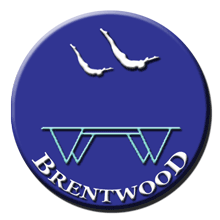The Technique of 'Arm Setting' - part 1
Let me begin by clarifying what I mean by “arm setting”. This is the process by which the trampolinist changes the arm action used in preparatory straight jumping in order to set up the ideal take-off position for the start of a single skill, the first skill in a routine or the first skill in a short training sequence.
The arm action in preparatory straight jumping is as described in my last GymCraft article ‘The Call to Arms”. The action can be simplistically described as a backward circling motion, where the arms are generally down when the bed is first contacted and swing forward and up during the bed depression and recoil phases. Although there are many idiosyncratic variations, the arms are normally still on their way up, to finish directly above the head as the airborne phase begins. (Fig 1)

Fig 1
While this process works well for straight jumping and can be applied without interruption when taking-off for all basic skills and all the backward rotating somersaults including the most complex, it is most ineffective for forward somersault take-offs. It can be seen (Fig 2) how, if no “arm set” is used, the arms are lifting forward and upward during the take-off phase for a forward somersault and as such they are moving in direct opposition to the intended direction of rotation.

Fig 2
In the early days of trampolining, this technique was indeed used for forward rotating somersaults and was even recommended in early publications. The method was still in use during the early 1970’s when I became conscious that a more efficient technique was needed. It was remarkable that performers, like John Beer, were still able to perform routines with a triffis start while using this contrary arm action - and on half inch beds into the bargain! The guinea pig for developing a new method was 12 year old Simon Rees, later to become European Youth Champion, World Age Group Champion and British Men’s Champion at the age of 15.
The technique we developed is now in widespread use throughout the world, for both forward and backward take offs, but we designed and used it exclusively for forward rotations, preferring to use a “natural” arm swing into all backward rotators. It is interesting to note that when Simon won the European Youth Championship, he was the only one using the “arm set” technique and even the technically aware Soviets were relying on the traditional arm action for forward take-offs at the start of their routines. However, they were not slow to recognise the merits of what we had developed and when they next fielded a team at a major Championship, every Soviet trampolinist opening with a forward rotating skill was using our method. I viewed this with a mixture of annoyance and pride. How dare they copy our work? But then again, isn’t imitation the sincerest form of compliment?
So how does the “arm set” differ from the standard arm swing, and why is it so effective in generating forward rotation? Primarily, it enables the arms to be directly overhead when the bed is at full depression. Compare the two diagrams showing the trampolinist at the start of the takeoff phase for a forward somersault. (Fig 3).

Fig 3
The bed is about to return and gymnast “A” is starting to raise her arms forward and upward, which is effectively a backward rotation and contrary to the intended direction of the forward somersault. Because of this contrary action, multiple rotations require an excessive amount of off-centre force from either a violent displacement of the hips or an excessive amount of forward lean. When this method was in vogue, multiple forward rotations inevitably lost height or travelled substantially. Gymnast “B”, however, is in a position where the arms can chop forward and down in total sympathy with the force from the bed being directed upwards and backwards, to create the desired multiple forward somersault. It is no surprise, therefore, that with skilful application of this technique, triple forward rotations can now be performed without travel and with minimal loss of height.
The essence of the technique is to ‘set’ the arms overhead at some time during the final descent to the bed prior to the take-off contact. It is a relatively simple matter to stop the normal straight jumping arm swing and hold the arms above the head, but to incorporate this within the final descent takes practice and exquisite timing to produce the best results. Many young trampolinists attempting the technique can be seen to interrupt their arm swing on the second last jump, resulting in the arms being overhead for the entire final jump, causing a serious loss of stability and the potential for injury to the lower back as the bed is contacted,
The method employed with Simon Rees was evolved by setting up the forward somersault with a tuck jump and I have yet to find a better way of teaching the “arm set,”
Method
- Perform a tuck jump followed by a straight jump. Note that the performer will probably exit the tuck jump with the arms in a downward position in order to swing them up into the straight jump.
- Ask the performer to exit the tuck jump by lifting the arms overhead and keep them there throughout the resultant straight jump. Care must be taken to ensure that the gymnast does not strike the bed with the back in an arched shape, and it is recommended that height be limited for these initial attempts.
- Once this can be done with accuracy and stability, the gymnast may attempt a tuck jump followed by a front somersault. The fact that the arms are now overhead at the start of the somersault take-off phase, provides incredible potential for increased rotational force and the coach must expect a degree of overthrow to result. It is essential, therefore, that a push mat is used to protect the somersault landing or the coach must step on to catch the performer. Indeed both mat and catch could be employed together.
- We now have tuck jump/front somersault and the next task is to get rid of the tuck jump whilst retaining the arm action.
- Ask the trampolinist to call out loudly “tuck” as they grasp their knees and “jump” as the legs kick down and the arms are placed overhead. This apparently silly exercise is essential for establishing the rhythm and timing of the arm drop to the knees and subsequent lift overhead. The coach may return to tuck jump/straight jump for this exercise prior to attempting it with the somersault. (Fig 4)

Fig 4
- Repeat this practice with a reduced leg bend in the tuck but maintaining the full arm action previously employed. Most important of all, the gymnast calls out “tuck” as the arms are dropped and “jump” as they are raised overhead. Once again this silly game establishes the rhythm and timing of the arm action so essential to effective performance. Because the knees are now only slightly bent, the arms and hands should touch down along the sides of the body, rather than reach for the knees.
- Finally the tuck jump is performed using the arm action only, with the pupil calling “tuck” and “jump” at the appropriate times despite the fact that there is now no leg bend on the word “tuck”.
- The technique can now be refined with the arms being brought down sideways to the sides of the body on the word “tuck”. If the arms are brought down in front, there may be a dishing in response to the arm drop. It is essential that good posture is maintained throughout the arm drop/lift and subsequent landing phase. The arms must be straight throughout the whole process.
- Clearly, the coach must use discretion as to when the calling out of “tuck” and “jump” are replaced by silent repetition in the pupil’s mind. When Simon Rees became British Men’s Champion, he was still muttering the two words to himself as he set his arms at the start of his voluntary routines. Indeed he still had a very slight knee flexion as he thought “tuck” and many of my fellow coaches picked up on this, thinking that it was a special technique to generate more power! Happily, none of the Judges saw fit to mark it as the first skill in his routine!
Although I am recommending the use of the tuck jump as a means of developing the ‘arm set’ technique, I must point out that far too many young trampolinists, when I ask them to perform a front somersault or a barani, respond “Can I put a tuck jump before it?” This habit, and indeed it is a habit, comes from the fact that as soon as front somersaults are required in compulsory routines, they are generally preceded by a tuck jump. This is further ingrained by the use of the same combination in voluntary routines. It is important that coaches ensure their pupils maintain the ability to perform forward somersault take-offs, independent of competition routine practice. Otherwise the tuck jump becomes a crutch which needs to be thrown away before skills, such as one and three-quarter front, are learned. If this hard line approach is not taken, you may find yourself coaching a performer who starts their voluntary routine with tuck jump, half out fliffis! It is far better not to allow this unnecessary habit to develop, as it can be very difficult to break and has even been thought to contribute to the “lost move syndrome.” It is far better to use the tuck jump as a means of developing an “arm set” and to separate it in the gymnast’s mind from the tuck jump used in routines.
In my next contribution to GymCraft, I will look at the variations and developments of the “arm set” because, believe me, it is not simply a matter of getting the arms overhead.
© Jack Kelly
 ®
®









